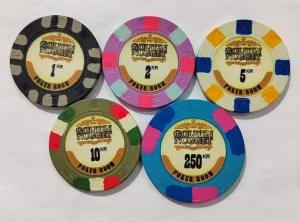What is Micro-Stakes Poker
Micro-stakes poker has become a distinct and intriguing option, especially prevalent in the online poker realm. My experience at various poker rooms has given me a thorough understanding of this variant, which I want to share based on my personal gaming experience.
Micro-stakes poker, as the term itself suggests, refers to games characterized by noticeably small stakes, usually in the range of $0.01 to $0.50. This micro-betting approach significantly lowers the financial barrier to entry, in stark contrast to the more substantial buy-ins and blinds found in conventional poker rooms. In land-based casinos, for example, minimum buy-ins are often $500, blinds start at $2-$4, and these stakes increase as the game is played. In contrast, micro-sphere poker targets a different audience, offering beginners a chance to learn the game without significant financial risk, and experienced players a chance to hone their strategies in a lower stakes environment.
The essence of micro stakes poker lies not only in the small amounts of money involved, but also in the unique strategic landscape it creates. The reduced financial pressures allow for greater exploration of tactics, players are more inclined to experiment with their style of play, take calculated risks and engage in hands they might avoid in a higher stakes environment. This flexibility contributes to dynamic and sometimes unpredictable poker, forcing players to adapt their strategies to a wide range of opponents and situations.
Types of Buy-Ins in Poker
In poker, players have many expectations and preferences that determine their approach to the game. Throughout my poker experience, I have played at different poker rooms and have played different blinds, ranging from micro stakes to big blinds in tournaments. Here I will try to understand the nuances of the different types of betting in poker based on my personal experience playing poker.

High Stakes Poker Games
High stakes poker games are the pinnacle of risk and reward, attracting experienced players with the promise of significant payouts. In these games, buy-ins typically start at $2,000, setting the stage for intense competition and high-level strategy. Participating in high stakes games requires not only a thorough understanding of poker mechanics, but also a strong emotional resilience, as the stakes can significantly increase the pressure of each decision. My experience playing high stakes poker has been both exciting and educational, providing lessons in patience, aggression, and the fine art of reading opponents.
High Stakes Poker Tournaments
High Stakes Poker Tournaments are designed for those who have been playing poker for a long time and have a clear confidence in their poker skills. With buy-ins ranging from $2,000 to $3,000, these tournaments offer a structured progression from table to table, culminating in large prize pools. The tournament format makes high stakes play more challenging, forcing players to adapt their strategies at different stages of the competition. Participating in these tournaments has sharpened my thinking, especially in terms of navigating the changing dynamics as the field narrows and the stakes increase.
Each type of poker game and betting structure presents its own challenges and opportunities. High stakes poker, whether in cash game or tournament format, requires a complex combination of skill, strategy, and mental toughness. Players must be prepared to make a significant financial commitment, but the potential rewards, both in terms of cash winnings and personal achievement, can be unprecedented.
What Bets are There in Micro-Stakes Poker
In this variant, the stakes are noticeably lower than in traditional poker games: they start at one cent and rarely exceed 50 cents. This unique structure creates an attractive, low-stress environment that gives newcomers a chance to hone their skills and try out different tactics.

These tournaments and cash games often attract beginners who want to gain hands-on experience without the fear and financial risks associated with higher stakes. Conversely, experienced players are also often drawn to micro stakes poker, seeing it as the perfect sandbox to experiment with new techniques, strategies and adjustments to their game without significant monetary consequences. This dual appeal makes micro stakes poker an arena that is full of players at different stages of their poker journey.
Micro-stakes poker is predominantly featured in online casinos. The digital nature of these games allows for a wide range of tables and tournaments to be offered around the clock, allowing players to play poker according to their schedules and preferences. The online platform also offers a wider range of betting levels in the micro-betting category, so each player can find a game that suits their comfort level and goals.
As we delve into the nuances of micro-betting poker, I will share with you ideas and strategies for navigating poker effectively. Based on my own experience of progressing to the professional level, I can attest that Micro Stakes poker has played an invaluable role in my development. It was in these low stakes games that I carefully honed my skills, experimented with various aspects of poker theory and developed the discipline that is the foundation of a successful game.
Should You Play Poker With Micro-Stakes
It is a common misconception that micro-stakes poker serves solely as a playground for beginners. My personal experience playing in these seemingly modestly sized stakes has shown that it is teeming with both budding talent and experienced players, each honing their skills, testing strategies, or simply enjoying poker without significant financial risk.
Micro-stakes poker is not just a stepping stone for beginners, but an environment for experimentation and skill development. Over the course of my participation in these games, I have employed new tactics, tweaked existing strategies and, most importantly, learned from a wide variety of opponents. The diverse competition, including experienced players masking their skill behind small stakes, creates a large number of learning opportunities. These games emphasized the importance of adaptability and constant learning, qualities necessary to navigate the complexities of poker at any stakes level.
One of the most important conclusions I have drawn from my experience playing micro-stakes games is the direct correlation between skill at these games and potential success in higher stakes games. The concept is simple, if a person has difficulty navigating micro-stakes poker, playing higher buy-ins will be a challenge that they are unlikely to be able to handle and save their money. Micro-stakes poker, with its minimal financial commitment, offers a platform to hone the gameplay, understand the nuances of the various poker variants and build a solid strategic foundation without the immediate pressure of significant losses.
Tips for Playing Poker With Micro-Stakes
Navigating micro stakes poker has been an important part of my poker experience and I have learned a lot from it. Unlike traditional or high stakes poker games, micro stakes poker presents a unique set of challenges and opportunities. The key to thriving in these games lies not only in understanding the fundamentals of poker, but also in adapting to the distinctive conditions and types of players that micro-stakes attracts.

Distinguishing between different types of poker players
One of the first lessons I learned in micro-stakes poker was the importance of recognizing the different types of players at the table. Tight players, aggressive loose players, and just plain loose players each bring a different approach to the game. Tight players are selective about their hands, often only going into the pot with premium hands. Aggressive-Loose players are more aggressive and willing to take risks and put pressure on their opponents with a wide range of hands. Just Loose players, on the other hand, are involved in a large number of hands without being aggressive. Successful micro-stakes poker requires strategies to counter each of these types of players and use their tendencies to your advantage.
Know when to fold
In micro-stakes, knowing when to fold is of paramount importance. This discipline is not only necessary to protect your chip stack in the present; it is also an essential habit for those seeking to play at higher stakes. Encounters with tight players who pose a particular threat with their aggression emphasize the need for knowledge of player types. Recognizing situations in which continuation is unfavorable is essential for long-term success.
Aggressive play
Aggression is a critical component of successful strategy in micro-stakes poker. Games tend to be more aggressive than higher stakes games, and both tight-aggressive and loose-aggressive players are noticeably present. Failure to make your presence known can lead to you being easily exploited, and the more aggressive players can dominate the game and win blinds with impunity. Timely raises and a show of strength can deter your opponents from attacking you, thereby preserving your position at the table.
Understanding positions and their strategic importance
A thorough understanding of position play has been invaluable in my micro-stakes endeavors. Early positions require caution due to the lack of information about other players’ actions, so it is recommended that you only enter the pot with strong hands. Late positions, on the other hand, offer strategic advantages by allowing you to learn about your opponents’ decisions before you act. This position allows you to be more aggressive, encouraging bluffing and more calculated betting against tight players. Mastering your position can make a big difference in the outcome of a game, allowing you to take advantage of situational advantages.
Throughout my experience playing poker with micro-stakes, this knowledge has played an important role in shaping my approach and strategy. Playing micro-stakes poker is not only about playing the game directly, but also about developing the skills, strategies and discipline necessary to move up to higher stakes. For beginners and experienced players alike, micro-stakes poker offers a great deal of room for development, requiring patience and aggressiveness.
Micro-Stakes Tournaments in Poker
Despite all the preconceptions about micro-stakes poker, it is a fascinating and challenging endeavor, as micro-stakes tournaments are a very difficult thing for many players who play in a professional poker league. Contrary to popular belief that these tournaments are reserved for newcomers looking to dive into competitive poker, I have found that they are lively venues where players of all skill levels gather. Indeed, experienced players often participate in micro-stakes tournaments not only for the thrill of it, but also as a place to practice strategies and test new tactics in a tournament setting.

Micro-stakes tournaments have unique features that set them apart from their higher stakes counterparts. One of the most notable features is the sheer number of participants – anywhere from a thousand to five thousand players. Getting through such a huge field and making it to the top is no small feat, it requires patience, flair and a deep understanding of the dynamics of the tournament. Such a wide range of participants turns every tournament into a marathon of poker skill, where stamina and adaptability are as important as technical skill. Making it to the final tables, or better yet, winning first place in a micro-stakes tournament is an accomplishment that speaks volumes about a player’s ability and readiness for the bigger, poker tournaments.
This environment offers, in a figurative sense, a testing ground for poker strategies without the use of significant financial stakes. My approach to these tournaments has been shaped by the realization that this is a place to hone skills, not to compete for first place. In the early stages of a tournament I take a conservative stance, focusing more on observing the tendencies of aggressive and weak players. This period of restraint is not passive; rather, it is a choice to allow the more reckless players to thin the ranks, thereby increasing my chances of making it through the tournament with a bigger stack.
When a tournament crosses the midway point, a change in playing style is necessary. With a smaller field and bigger blinds, a more aggressive stance becomes paramount. At this stage of the game, I introduce more bluffs into the game and use narrowly aggressive strategies more extensively. This transition represents a balance: while maintaining the caution of the early game, I take advantage of opportunities to accumulate chips with more aggressive tactics.
Conclusion
Micro-limit poker serves as the perfect place for those players who are just starting out and learning the basics of poker. Before you play big or medium buy-in poker, I strongly advise you to try Micro-Stakes poker. And if you are an experienced poker player and are wondering if you need this type of poker, I would say that playing it for fun and gaining some experience is not a good idea, but if you have a new strategy or style of play that you want to try out, this place is perfect for you because you are not risking a lot of money. So it all depends on what kind of player you are and what your goals are.

